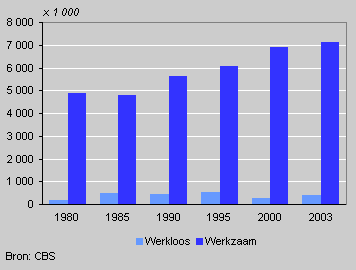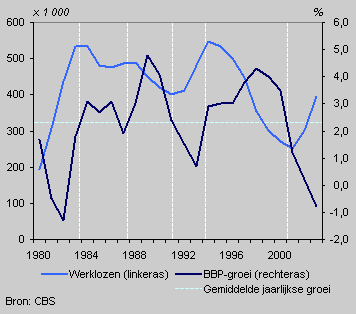Unemployment and economic growth

Unemployment has risen sharply in the last two years. In 2001 an average 252 thousand people were unemployed in the Netherlands. By 2003 this had grown to 396 thousand. In the first months of 2004, too, unemployment has continued to rise.
The increase in unemployment is connected with the low economic growth. In the period 1980–2003 unemployment rose every time economic growth dropped below 2.3 percent.
Growth needed to absorb increased labour supply
Population growth and increasing labour participation have resulted in an increasing inflow into the labour force. From 1980 to 2003 the labour force grew continuously from 5 million people to 7.5 million. A certain level of economic growth is required to provide work for all these people. In addition, technological developments, such as increasing automation, have led to a situation in which the same production level can be achieved with fewer workers.
Labour force growth

Delayed reaction
The turning points of low economic growth do not coincide with turning points of high unemployment. The labour market responds with a delay to economic developments. It is therefore possible that unemployment continues to grow while economic growth has already picked up again.
Following the economic low points in 1982 and 1983, for example, there were periods of jobless growth. The economy has to recover to a certain level before the rise in unemployment comes to a halt.
Vice versa, a fall in economic growth does not lead to an immediate increase in unemployment. More recently, unemployment only started to increase in 2001 while the economy had been declining for a while.
In the period 1980–2003 the turning points for unemployment took place when economic growth was at a level of around 2.3 percent, the average annual growth for the whole period.
Unemployment and economic growth

Remko Hijman
Source: Sociaal-economische trends